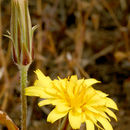Comments
(
الإنجليزية
)
المقدمة من eFloras
Agoseris parviflora is found in drier habitats from western Great Plains to eastern foothills of the Cascade Mountains and Sierra Nevada. This is A. glauca var. laciniata of recent authors. The inclusion of A. parviflora within an expanded A. glauca is based partly on the mistaken perception that those two species readily intergrade and that A. parviflora is a xeric variant of the more mesic A. glauca. Although hybrids between the two species occur, frequency of intermediates is no greater than that of any other species in the genus. Agoseris parviflora is known to form intermediates with A. aurantiaca, A. monticola, and A. retrorsa as well. This species exhibits some regional variations. In their extremes, these phases appear more or less distinct but they so completely intergrade that their separation becomes arbitrary.
- ترخيص
- cc-by-nc-sa-3.0
- حقوق النشر
- Missouri Botanical Garden, 4344 Shaw Boulevard, St. Louis, MO, 63110 USA
Description
(
الإنجليزية
)
المقدمة من eFloras
Stems 0. Leaves erect to decumbent; petioles sometimes purplish, margins usually ± hairy, sometimes glabrous or ciliate; blades linear-lanceolate to oblanceolate, (5–)10–20(–32) cm, margins usually lobed, sometimes entire (variable within plants, e.g., outer entire, inner lobed), rarely all entire; lobes (3–)5–8 pairs, linear to lanceolate, mostly retrorse, sometimes spreading; lobules often present, faces glabrous and glaucous or densely tomentose. Peduncles not notably elongating after flowering, [(6–)10–25(–45) cm in fruit], glabrate, or apically hairy to lanate, eglandular. Involucres obconic to hemispheric, 2–3.5 cm in fruit. Phyllaries in 2–3 series, usually medially rosy purple, rarely all green or spotted, margins ciliate or lanate, faces glabrous or sparsely villous, eglandular; outer erect or spreading, adaxially ± tomentose (sometimes glabrous); inner erect, not notably elongating after flowering. Receptacles epaleate. Florets 30–100; corollas yellow, tubes (4–)6–15 mm, ligules 10–20 × 2–4 mm; anthers 3–5 mm. Cypselae 9–18 mm, bodies terete or narrowly conic to obconic, 5–9 mm, beaks 3–10 mm, lengths (1/2–)2 times bodies; pappus bristles in ca. 3 series, 10–20 mm. 2n = 18.
- ترخيص
- cc-by-nc-sa-3.0
- حقوق النشر
- Missouri Botanical Garden, 4344 Shaw Boulevard, St. Louis, MO, 63110 USA
Synonym
(
الإنجليزية
)
المقدمة من eFloras
Troximon parviflorum Nuttall, Trans. Amer. Philos. Soc., n. s. 7: 434. 1841; Agoseris caudata Greene; A. dens-leonis Greene; A. glauca (Pursh) Rafinesque var. laciniata (D. C. Eaton) Kuntze; A. leptocarpa Osterhout; A. rosea (Nuttall) D. Dietrich; A. taraxacoides Greene; A. tomentosa Howell
- ترخيص
- cc-by-nc-sa-3.0
- حقوق النشر
- Missouri Botanical Garden, 4344 Shaw Boulevard, St. Louis, MO, 63110 USA

